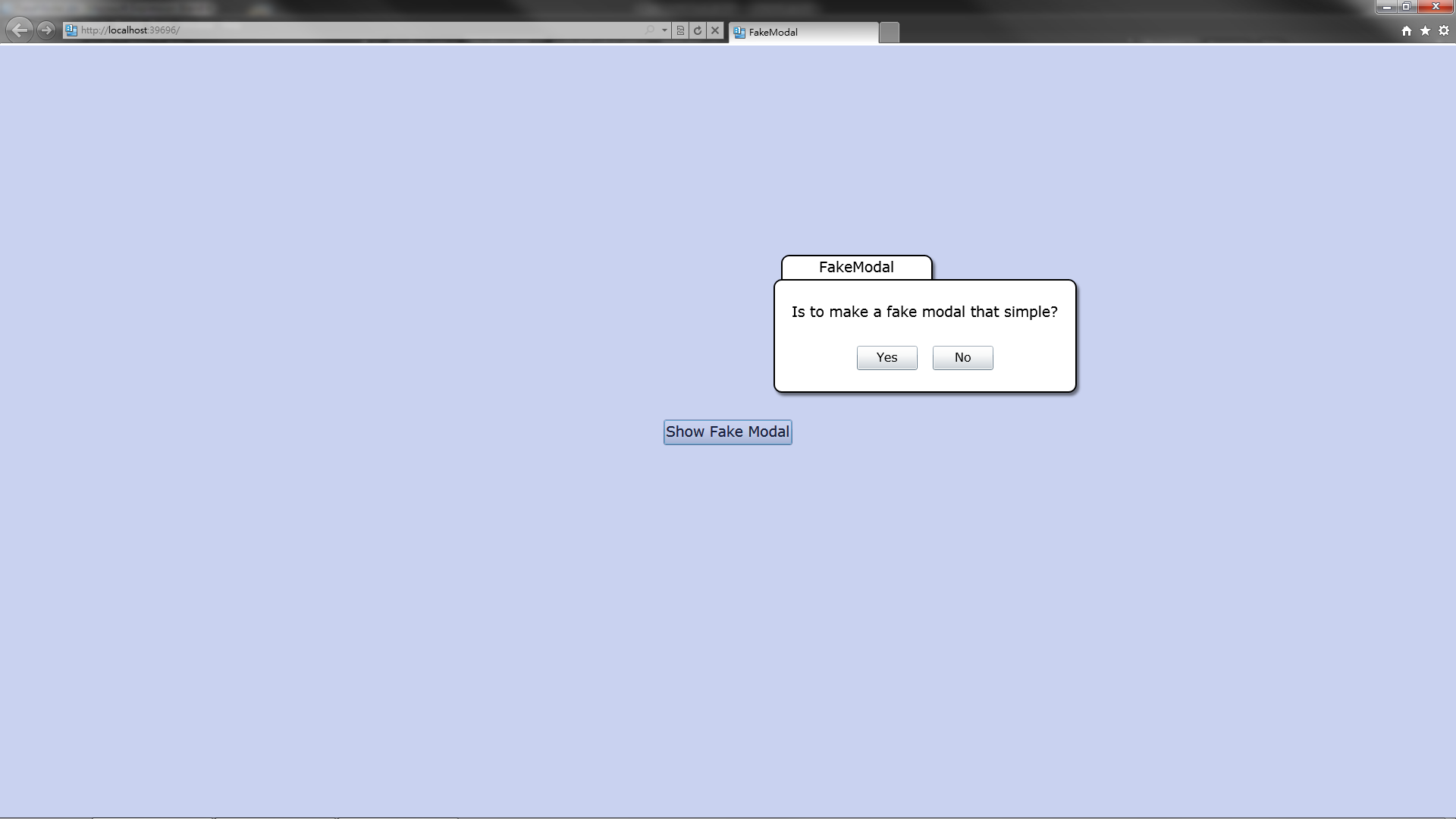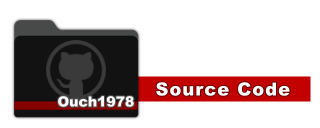自製 Modal 元件
· 預估閱讀時間: 4 分鐘
有使用過 Silverlight/WPF 的朋友們不知道有沒有遇過一個問題:有時候想要跳出一個元件跟使用者互動,而且要鎖住原來的主畫面,等使用者操作完才能繼續操作主畫面,可是用 MessageBox 的話功能不夠,用 ChildWindow 的話功能又太多或是太複雜之類的問題...
難道就不能自訂一個元件,當它顯示的時候,會自動讓主畫面被鎖住,而且該元件的外觀和操作方式都可以自訂嗎?其實只要善用 Grid 容器,就可以簡單的做到這個功能喔!!
方法如下:
步驟一
首先我們打開一個標準的 Silverlight+Web 專案( WPF 也可以喔),接著增加一個 UserControl (範例中取名為 MyModalControl )。
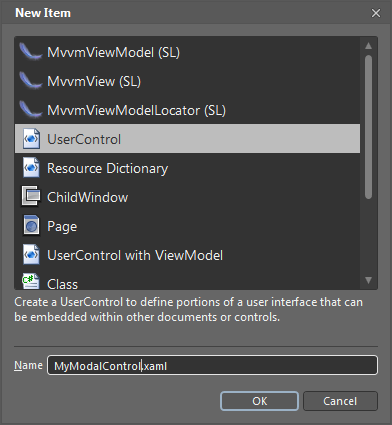
接著修改 MyModalControl.xaml 的內容,將 控制項本身 與 LayoutRoot 這個 Grid 的 寬和高都設為 Auto。
步驟二
修改 LayoutRoot 的 背景色為 #4C4969CC(透明度為 30%)
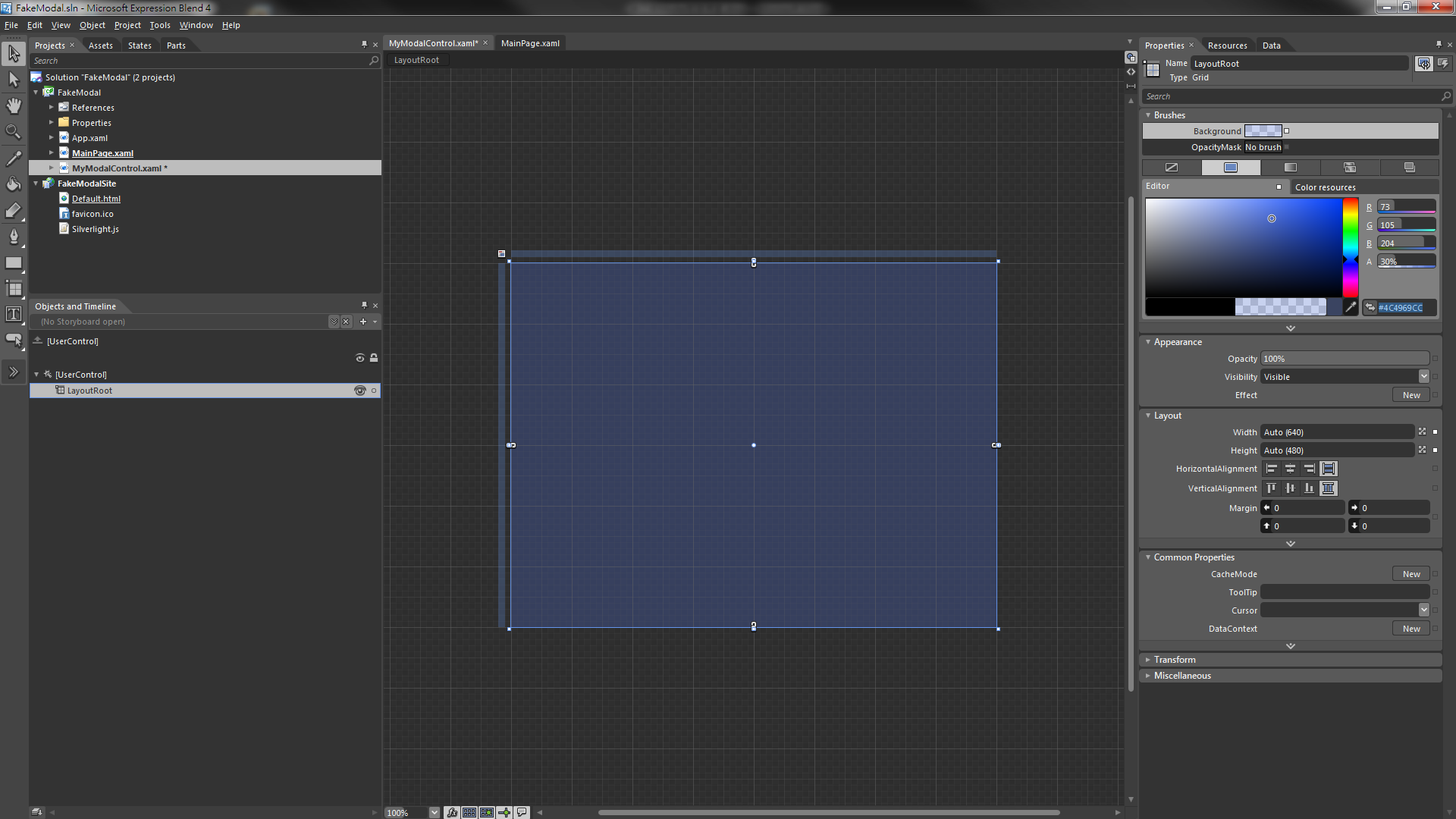
步驟三
放置要和使用者互動的元件,為了精簡教學過程,怎麼做的這邊就不詳述,完成後如下圖。
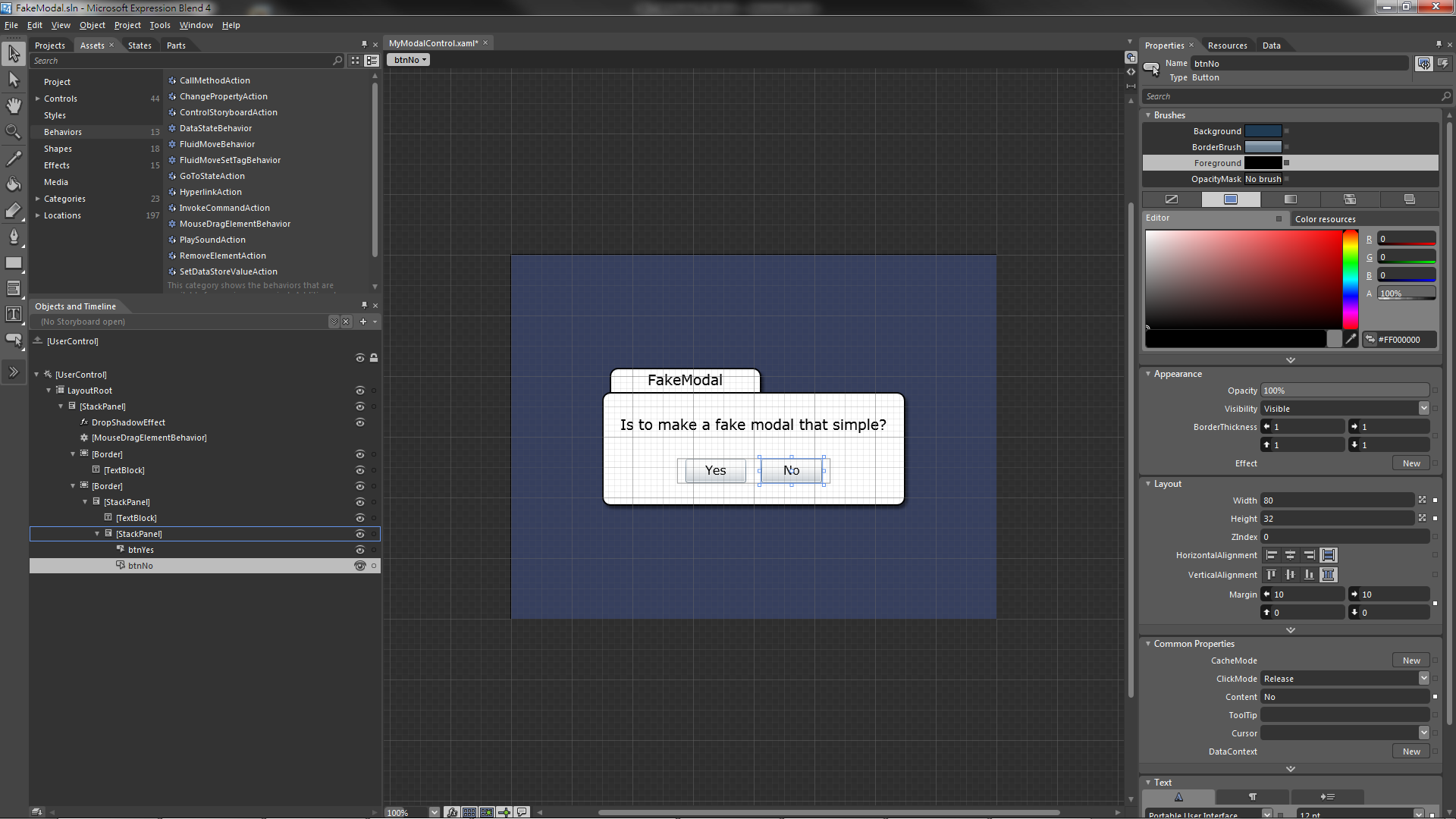
步驟四
加入按鈕的 Click 事件,並加入移除這個控制項的程式碼,完成後的 xaml 與 cs 檔如下:
<UserControl x:Class="FakeModal.MyModalControl"
xmlns="http://schemas.microsoft.com/winfx/2006/xaml/presentation"
xmlns:x="http://schemas.microsoft.com/winfx/2006/xaml"
xmlns:d="http://schemas.microsoft.com/expression/blend/2008"
xmlns:ei="http://schemas.microsoft.com/expression/2010/interactions"
xmlns:i="http://schemas.microsoft.com/expression/2010/interactivity"
xmlns:mc="http://schemas.openxmlformats.org/markup-compatibility/2006"
d:DesignHeight="480"
d:DesignWidth="640"
mc:Ignorable="d">
<Grid x:Name="LayoutRoot"
Background="#4C4969CC">
<StackPanel HorizontalAlignment="Center"
VerticalAlignment="Center">
<StackPanel.Effect>
<DropShadowEffect Opacity="0.5" />
</StackPanel.Effect>
<i:Interaction.Behaviors>
<ei:MouseDragElementBehavior ConstrainToParentBounds="True" />
</i:Interaction.Behaviors>
<Border Width="200"
Height="32"
Margin="10,0,0,0"
HorizontalAlignment="Left"
Background="White"
BorderBrush="Black"
BorderThickness="2,2,2,0"
CornerRadius="10,10,0,0">
<TextBlock HorizontalAlignment="Center"
VerticalAlignment="Center"
FontSize="18.667"
Text="FakeModal"
TextWrapping="Wrap" />
</Border>
<Border Width="400"
Height="150"
Background="White"
BorderBrush="Black"
BorderThickness="2"
CornerRadius="10">
<StackPanel HorizontalAlignment="Center"
VerticalAlignment="Center">
<TextBlock Margin="0"
FontSize="18.667"
Text="Is to make a fake modal that simple?"
TextWrapping="Wrap" />
<StackPanel Margin="0,30,0,0"
HorizontalAlignment="Center"
VerticalAlignment="Center"
Orientation="Horizontal">
<Button x:Name="btnYes"
Width="80"
Height="32"
Margin="10,0"
Click="btnYes_Click"
Content="Yes"
FontSize="16" />
<Button x:Name="btnNo"
Width="80"
Height="32"
Margin="10,0"
Click="btnNo_Click"
Content="No"
FontSize="16" />
</StackPanel>
</StackPanel>
</Border>
</StackPanel>
</Grid>
</UserControl>
using System.Windows.Controls;
namespace FakeModal
{
public partial class MyModalControl : UserControl
{
public MyModalControl()
{
InitializeComponent();
}
private void btnYes_Click(object sender, System.Windows.RoutedEventArgs e)
{
//you can do something here.
(this.Parent as Panel).Children.Remove(this);
}
private void btnNo_Click(object sender, System.Windows.RoutedEventArgs e)
{
//you can do something here.
(this.Parent as Panel).Children.Remove(this);
}
}
}
步驟五
到這邊就算是完成啦,再來就是讓它上場表演的時候了,在 MainPage.xaml 放一個 Button 叫它出來吧!!
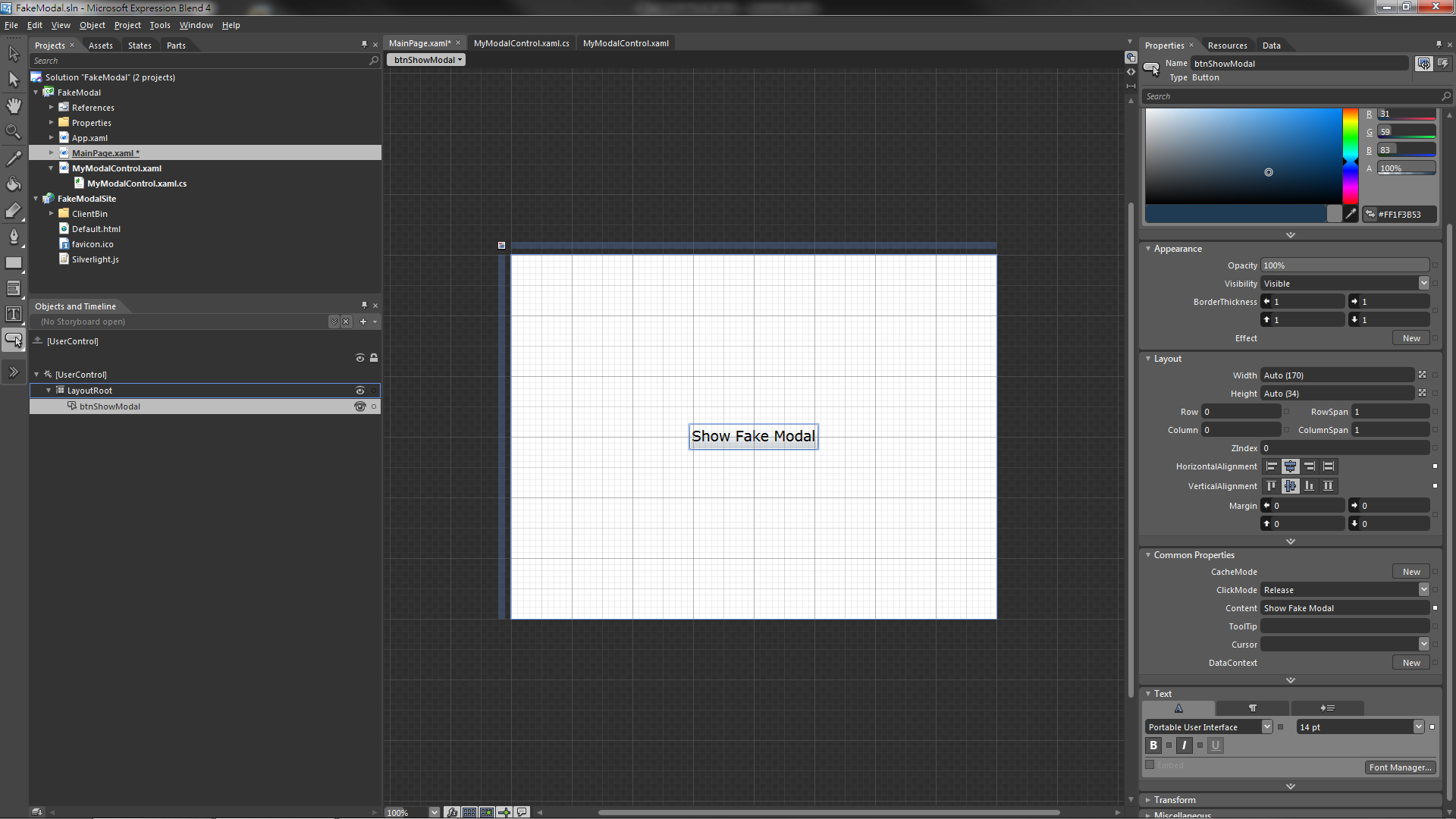
<UserControl x:Class="FakeModal.MainPage"
xmlns="http://schemas.microsoft.com/winfx/2006/xaml/presentation"
xmlns:x="http://schemas.microsoft.com/winfx/2006/xaml"
Width="Auto"
Height="Auto">
<Grid x:Name="LayoutRoot"
Background="White">
<Button x:Name="btnShowModal"
HorizontalAlignment="Center"
VerticalAlignment="Center"
Click="btnShowModal_Click"
Content="Show Fake Modal"
FontSize="18.667" />
</Grid>
</UserControl>
using System.Windows.Controls;
namespace FakeModal
{
public partial class MainPage : UserControl
{
public MainPage()
{
InitializeComponent();
}
private void btnShowModal_Click(object sender, System.Windows.RoutedEventArgs e)
{
this.LayoutRoot.Children.Add( new MyModalControl());
}
}
}
大功告成!!
